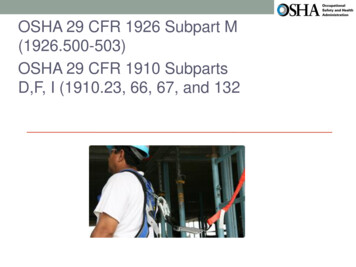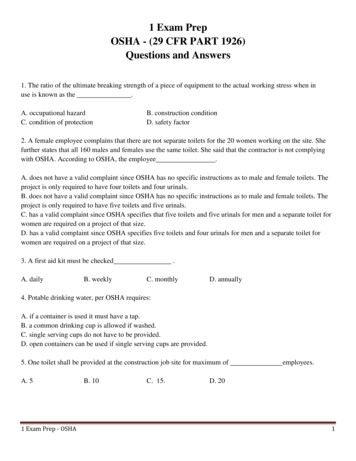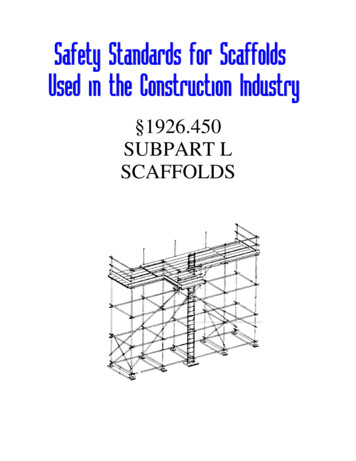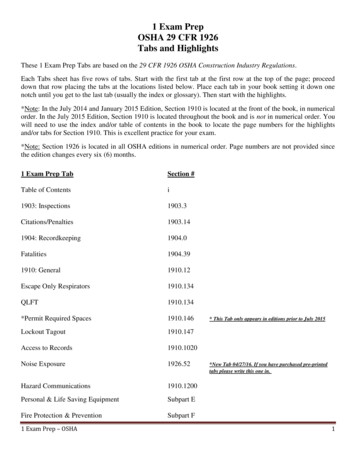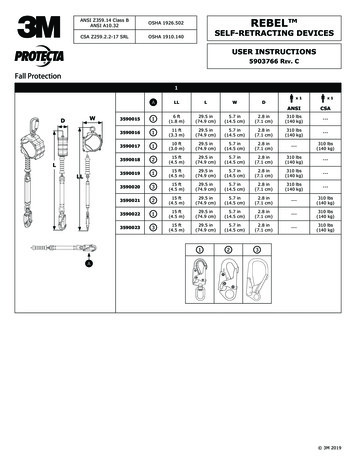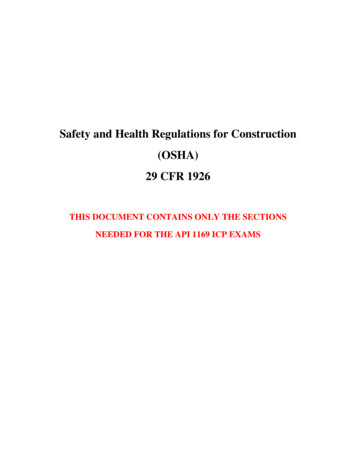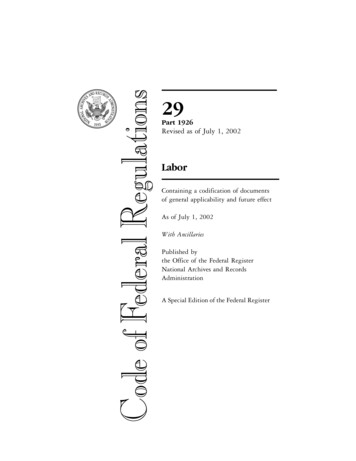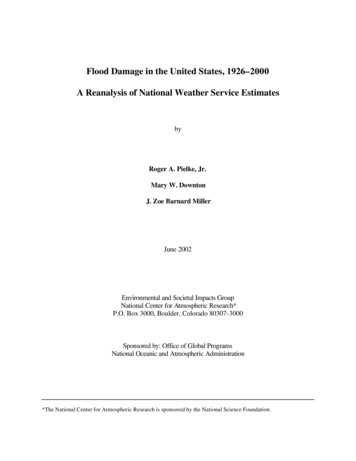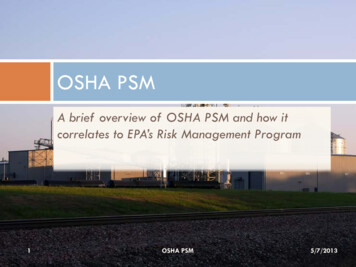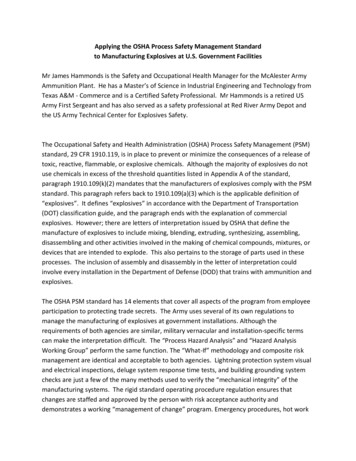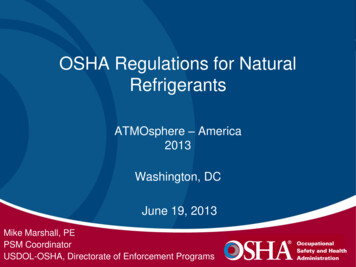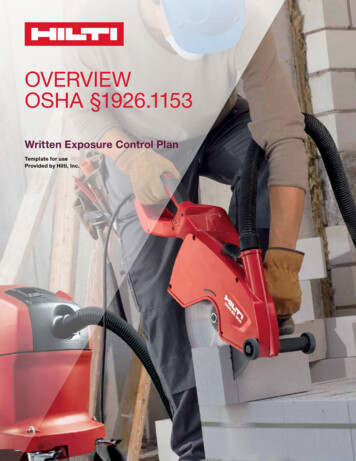
Transcription
OVERVIEWOSHA §1926.1153Written Exposure Control PlanTemplate for useProvided by Hilti, Inc.
OVERVIEWOSHA §1926.1153Written ExposureControl PlanIn its published Docket, OSHA says the purpose of the plan is to “help limit exposure torespirable crystalline silica to as few employees as possible.”Elsewhere, OSHA says: “Written exposure control plans provide a systematic approach forensuring proper function of engineering controls and effective work practices that can preventoverexposures from occurring. OSHA expects a written exposure control plan will be instrumentalin ensuring that companies comprehensively and consistently protect their employees.”ACCORDING TO OSHA §1926.1153(g)(1), A WRITTEN EXPOSURE CONTROL PLAN MUSTCONTAIN AT LEAST THE FOLLOWING FOUR ELEMENTS:(i) “ A description of the tasks in the workplace that involve exposure to respirable crystalline silica;”(ii) “A description of the engineering controls, work practices, and respiratory protection used to limit employee exposure torespirable crystalline silica for each task;”(iii) “A description of the housekeeping measures used to limit employee exposure to respirable crystalline silica;” and(iv) “A description of the procedures used to restrict access to work areas, when necessary, to minimize the number ofemployees exposed to respirable crystalline silica and their level of exposure, including exposures generated by othercompanies or sole proprietors.”ADDITIONAL REQUIREMENTS PERTAINING TO THE WRITTEN EXPOSURE CONTROL PLAN:1926.1153(g)(2) “The company shall review and evaluate the effectiveness of the written exposure control plan at leastannually and update it as necessary.”1926.1153(g)(3) “The company shall make the written exposure control plan readily available for examination and copying,upon request, to each employee covered by this section, their designated representatives, the AssistantSecretary and the Director.”1926.1153(g)(4) “The company shall designate a competent person to make frequent and regular inspections of job sites,materials, and equipment to implement the written exposure control plan.”SAMPLE EXPOSURE CONTROL PLAN:DBS 08/17The following is a general template for a sample Exposure Control Plan (“ECP”). It includes topics addressed in the Rule,beyond those specified for an ECP. This ECP template is general in nature, with titles and various sections containing languagefor consideration — the ECP must be tailored for each specific company, which may require additions / changes / deletions.Highlighted sections are not able to be generally-addressed, and must be determined by each company. Consult OSHA§1926.1153 for complete details. This ECP is provided without representation of any kind as to its accuracy, completeness, oradequacy.Hilti, Inc. (U.S.) 1-800-879-8000en español 1-800-879-5000www.hilti.com
TABLE OF CONTENTS:1. Company information2. Worksite information3. Purpose and responsibilitiesa. Company responsibilitiesb. Competent Personi. Identificationii. Responsibilitiesc. Supervisor responsibilitiesd. Employee responsibilities4. Health hazards from Silica exposure5. Employee traininga. Training program contentb. Frequency/tracking6. Risk assessmenta. Exposure limitsb. Silica-generating tasks — Controlsi. Task Assessmentii. Task list — generaliii. Special tasksiv. General housekeepingv. Training — Controlsvi. Additional requirementsvii. Employee notificationc. Bystander exposuresi. Company-generated Silica exposuresii. 3rd-party generated Silica exposures7. Personal protective equipmenta. PPE requirements for Silicab. Respiratory protectioni. Program requirementsI. Employee training — content/frequency/trackingII. Fitness testing — content/frequency/trackingii. Frequency of use — tracking8. Medical surveillancea. PLHCPi. PLHCP listii. Medical examination requirementsiii. Documentation provided by Company to PLHCPiv. PLHCP’s written medical report to employeev. PLHCP’s written medical opinion to Company — requirementsvi. Specialist9. Record keepingDBS 08/1710. ReviewHilti, Inc. (U.S.) 1-800-879-8000en español 1-800-879-5000www.hilti.com
OVERVIEWOSHA §1926.1153Written ExposureControl Plan1. COMPANY INFORMATION Insert company information here 2. WORKSITE INFORMATIONDBS 08/17 Insert worksite information here Hilti, Inc. (U.S.) 1-800-879-8000en español 1-800-879-5000www.hilti.com
OVERVIEWOSHA §1926.1153Written ExposureControl Plan3. PURPOSE AND RESPONSIBILITIESii. ResponsibilitiesThe purpose of this Exposure Control Plan (ECP) isto identify potential sources of employee exposureto respirable crystalline silica dust (“Silica”), specifyappropriate engineering controls and work practices tolimit exposure, and address the use of personal protectiveequipment where exposures exceed applicable limits(collectively, “Controls”). The ECP also addresses othertopics listed in 29 CFR 1926.1153 (the “Rule”), includingemployee training, a medical surveillance program, and arecord retention policy. The requirements of this ECP donot apply to employees who are not reasonably expectedto be exposed to Silica at or above the AL, as defined insection 4, below.The Competent Person shall have fullknowledge of this ECP; and shall be capableof identifying existing and foreseeable Silicahazards in the workplace, including the ability(or access to an individual with the ability),to perform risk assessments as set forth insection 6, below. The Competent Personshall have authorization to take promptcorrective measures to eliminate or minimizeSilica hazards, and have the knowledgeand ability necessary to make frequent andregular inspections of job sites, materials, andequipment to implement this ECP.c. Supervisor responsibilitiesa. Company responsibilitiesThe Company is responsible for development of theECP, and overall responsibility for its implementationand review.b. Competent personi. Identification Insert names/roles per jobsite Supervisors shall have general knowledge of theRule and this ECP, and specific knowledge of thecontents of sections 6 and 7, below. Supervisorsshall ensure their subordinates are trained on theproper use of all Controls; and that all Controlrequirements contained in this ECP are fully andproperly implemented.In general, full-shift exposure to visible Silica dustwill exceed the PEL. If such a condition exists, thesupervisor shall immediately investigate, involvingthe Competent Person as necessary, to mitigate theexposure.DBS 08/17 Insert names of supervisors per jobsite Hilti, Inc. (U.S.) 1-800-879-8000en español 1-800-879-5000www.hilti.com
OVERVIEWOSHA §1926.1153Written ExposureControl Pland. Employee responsibilitiesEmployees are responsible for understanding theECP, the Rule and applicable Safety Data Sheets,and where they can be located; and fully andproperly implementing all Control requirements ascontained in this ECP. Employees shall immediatelynotify their supervisor and/or the Competent Personif they have reason to believe excess Silica exposureis occurring, or experience signs or symptoms ofsilica-related illness.4. H EALTH HAZARDS FROM SILICAEXPOSURESilica is quartz, and the less common cristobalite andtridymite. Silica (quartz) is present in many commonconstruction materials, including concrete, mortar, block,brick, stone, and asphalt. Airborne dust is created whenthese materials are disturbed, such as by cutting, coring,drilling, demolishing, or grinding. A portion of this dust is“respirable” ( 10 microns in size — very fine particles whichcan reach the lungs); and a portion of this respirable dustis silica. The silica content of dust varies by material andgeography.DBS 08/17Prolonged overexposure to Silica can result in health-relatedinjury, including silicosis, cancer, tuberculosis, chronicbronchitis, and immune system and kidney effects. TheRule has established exposure limits intended to protectemployees from these effects. These limits include an ActionLevel (“AL”) of 25 µg/m3 as an 8-hour Time Weighted Average(“TWA”), and a Permissible Exposure Limit (“PEL”) of 50 µg/m3 as an 8-hour TWA.Hilti, Inc. (U.S.) 1-800-879-8000en español 1-800-879-5000www.hilti.com
OVERVIEWOSHA §1926.1153Written ExposureControl Plan5. EMPLOYEE TRAININGb. Frequency/tracking Insert task list here a. Training program contentEach employee shall be trained on Silica exposure incompliance with the OSHA Hazard Communicationstandard, 29 CFR 1910.1200. Training shall ensurethe employee can demonstrate knowledge andunderstanding of the health hazards associatedwith exposure to Silica, the specific situations intheir workplace where Silica exposure may occur,the specific measures implemented to protect themfrom exposure to Silica (including Controls), and thecontent of the Rule.DBS 08/17 Insert training program content here Hilti, Inc. (U.S.) 1-800-879-8000en español 1-800-879-5000www.hilti.com
OVERVIEWOSHA §1926.1153Written ExposureControl PlanAn initial assessment must be conducted for all workrelated situations where an employee may experience Silicaexposure. This includes employees engaged in a Silicagenerating task, as well as employees in the vicinity of Silicagenerating tasks being performed by others (“Bystanders”).The assessment shall be based on exposure without use ofControls. Where exposures may reasonably be expected toreach or exceed the AL, action must be taken as set forth inthis ECP.a. Exposure limitsThe Rule requires employee exposure to Silica bekept below the PEL. Where, after instituting allfeasible engineering controls and work practices,exposures remain above the PEL, respiratoryprotection is required.b. Silica-generating tasks — Controlsi. Task AssessmentFor each Silica-generating task where exposuremay be at or above the AL, engineering controlsand/or work practices must be instituted. Whenthese are not sufficient to reduce exposureto or below the PEL, then in addition to usingengineering controls and/or work practices toreduce exposure to the lowest feasible level, asuitable respirator must be utilized.There are three methods for assessing exposure.For each of the tasks listed in the following section(ii), one of these three methods shall be specified,and associated support documentation maintained:I. T able 1 of the Rule: a list of tasks andassociated Controls which, if fully andproperly implemented, are deemed to maintainexposure below the PEL without furtherassessment (note that in some cases theControls include a respirator requirement);II. Performance Option: use of any combinationof air monitoring data or Objective Datasufficient to accurately characterize employeeexposure. The Objective Data must reflectthe same or higher exposure potential asHilti, Inc. (U.S.) 1-800-879-8000en español 1-800-879-5000www.hilti.comthe task to be performed. Objective Datadocumentation must specify its source, basematerial worked on, test protocol and results,a description of the task being performed, andany other information that would be relevant tothe assessment; orIII. Scheduled Monitoring Option: personalbreathing zone air samples that establishexposure for a “shift job work area”.Representative sampling is permitted, as longas sampling is performed on the highestexposure employee(s). Test records shallcontain the date of the measurement; thetask; sampling and analytical methods;number, duration and results of the test;identity of laboratory that performedthe analysis (laboratory must meet therequirements of the Rule Appendix A); type ofPPE worn by the employees tested; the name,SSN, and job classification of all employeesrepresented by the test; and the name of theemployee(s) tested. Testing frequency shall beperformed as follows:1. I f initial monitoring indicates thatemployee exposures are below the AL,monitoring may be discontinued forthose employees whose exposures arerepresented by such monitoring;2. Where the most recent exposuremonitoring indicates that employeeexposures are at or above the AL but ator below the PEL, the monitoring shall berepeated within six months of the mostrecent monitoring. Note that if exposuremonitoring indicates the exposure isabove the PEL, additional Controls mustbe implemented to reduce exposurebelow the PEL; here the most recent exposure3. Wmonitoring indicates that employeeexposures are above the PEL, themonitoring shall be repeated within threemonths of the most recent Monitoring.Note, in addition, Controls must beimplemented to reduce exposure belowthe PEL;DBS 08/176. RISK ASSESSMENT
OVERVIEWOSHA §1926.1153Written ExposureControl Plan4. W here the most recent (non-initial)exposure monitoring indicates thatemployee exposures are below theAL, the monitoring shall be repeatedwithin six months of the most recentmonitoring until two consecutivemeasurements, taken seven or moredays apart, are below the AL, at whichtime monitoring may be discontinued forthose employees whose exposures arerepresented by such monitoring. Insert task list here (continued) ii. Task list — generalThe following is a list of tasks and activities,the method of exposure compliance, and theassociated Controls (including engineeringcontrols, work practices, and respiratorrequirements):Examples: hammer drilling; grinding;cutting — see, as an example of a Controlmethod for hammer drilling with on-boarddust collection, the attached Hilti SubmittalPackage for hammer drilling with on-boardDRS DBS 08/17 Insert task list here Hilti, Inc. (U.S.) 1-800-879-8000en español 1-800-879-5000www.hilti.com
OVERVIEWOSHA §1926.1153 Insert task list here (continued) DBS 08/17 Insert task list here (continued) Written ExposureControl PlanHilti, Inc. (U.S.) 1-800-879-8000en español 1-800-879-5000www.hilti.com
OVERVIEWOSHA §1926.1153Written ExposureControl PlanFor tasks where exposure is assessedbased on Scheduled Monitoring (section(i)(III), above), all affected employees andtheir representatives shall be provided theopportunity to observe the monitoring.Within fiv
OSHA 1926.1153 Written Exposure Control Plan Hilti, Inc. (.S.) 1-800-879-8000 en espaol 1-800-879-5000 www.hilti.com DBS 08/17 d. Employee responsibilities Employees are responsible for understanding the ECP, the Rule and applicable Safety Data Sheets, and where they can be located; and fully and properly implementing all Control requirements as contained in this ECP. Employees shall .
